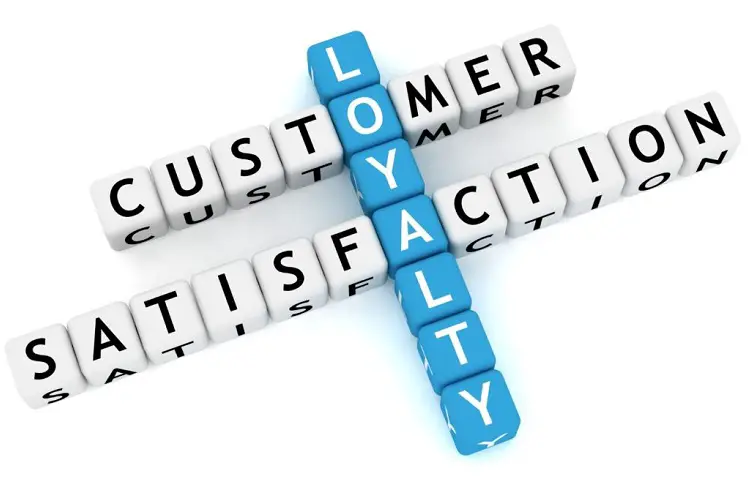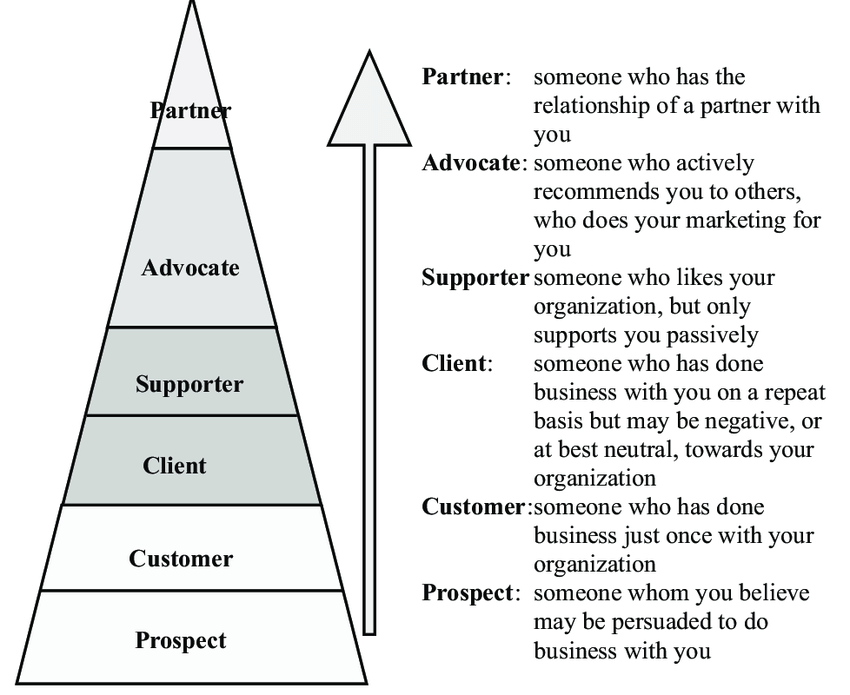Customer Loyalty
 Graphics courtesy of ProspectrusOpens in new window
Graphics courtesy of ProspectrusOpens in new window
Since it is now widely recognized that it is much less costly and much more profitable to keep existing customers than to win new ones, customer retentionOpens in new window has become an important goal for most organizations. In principle it’s simple: you just have to keep your existing customers. But how? Many companies have adopted the idea of customer loyalty to spearhead their retention strategiesOpens in new window, but it is very doubtful whether the loyalty concept is fully understood or effectively implemented by many who embrace it. |
Loyal is a historical word, rooted in feudal times when allegiance to the sovereign was fundamental to the success, perhaps even the survival, of the state. The Oxford Dictionary’s definition of the word “loyal” is:
True or faithful (to duty, love or obligation); steadfast in allegiance, devoted to the legitimate sovereign or government of one’s country.
- On that basis, why should anybody be loyal to a commercial enterprise?
- What legitimacy does the enterprise possess?
- Why do its customers have any obligation to show allegiance to it?
Of course they don’t, and the more the education, confidence and power of consumers have grown, the more they realize it. In fact, in the twenty-first century is the other way round. It is the customer who is king and the supplier that needs to be loyal to its customers! It is the supplier that must be ”true, faithful and steadfast in allegiance to meeting the legitimate needs of its customers”.
It is the woeful misunderstanding of the loyalty concept amongst senior managers (and especially amongst the marketing profession — the very people who ought to know better) which has been responsible for the plethora of misguided strategies which have been introduced in the name of securing customer loyalty.
Many involve cheap attempts to bribe the customer. How many leaders have secured the long-term loyalty of their citizens/followers/employees by such tactics?
Whether you are president of a country or a company, loyalty has to be earned. Let’s examine this through the eyes of the educated, confident and increasingly powerful customers.
Why should they choose to continue to give their business to the same supplier? The answer is simple. That supplier has to meet their needs better than any of the alternative suppliers.
The total product (total value package) offered by the supplier has to meet or exceed the customer’s requirements to result in customer satisfaction. To secure customer retention in a competitive market the supplier’s total value package has to match customer’s requirements better than anything offered by competitors.
Clearly, we need to clarify the whole concept of loyalty and how it applies to the relationship between a commercial enterprise and its customers. That is the purpose of the remainder of this discussion.
Types of Loyalty
There are many types of loyalty, many reasons why suppliers retain the business of their customers.
| Table X-1 | Types of Loyalty |
|---|
|
As shown in Table X-1, most loyalty bear little relation to the true meaning of the word loyalty, involving very little allegiance, devotion or duty. Monopoly loyalty is an extreme example, but does illustrate the point.
Where customers have little or no choice, their “loyalty” is far from devoted. It is often resentful. Empirical evidence based on hundreds of customer satisfaction surveys shows that customers with little or no choice often feel very dissatisfied. Other suppliers are notionally in a competitive situation. Their customers could use alternative suppliers — in theory. In some situations, however, the cost, difficulty or hassle factor involved in changing suppliers is so great that customers will do it only as a last resort.
Again, our research shows that they will live with much lower than normal levels of satisfaction before they switch suppliers. But this reluctance to change suppliers cannot be describe as “loyalty”. It certainly involves little allegiance, duty or devotion.
Incentivized loyalty has possibly been the most over-hyped marketing strategy in recent years. It may have some effect on customers who are not spending their own money, frequent business flyers being an obvious example, but the success of Southwest AirlinesOpens in new window in the US and EasyjetOpens in new window in the UK is already dispelling that myth.
Most people in the UK hold the “loyalty” cards of more than one competing supermarket, store group, airline or petrol station. They see the loyalty point as something they may as well take when it meets their wider needs to use that supplier.
Tellingly, the UK supermarket which has gained the highest percentage increase in its market share in recent years is Asda. It offers a very wide product range and focuses on value and service. In 1999 AsdaOpens in new window trialled a loyalty card, known as the Asda Club Card, but withdrew it when their research showed that customers preferred lower prices rather than points. Asda’s market share has never been higher and it is the only one of the big four UK supermarket multiples which does not have a loyalty card!
Habitual loyalty may be the most common form of repeat business. As time becomes an increasingly scarce commodity for many customers, familiar routines that can be quickly accomplished with minimal thought become part of the lifestyle.
|
Companies with high levels of customer retention may feel a misleading sense of security because allegiance to suppliers in these situations can be very low. If a new supermarket, pub or petrol station opens which is more convenient, bigger, more modern or more competitively priced, the original supplier may find that there was very little “loyalty” under-pinning the previous levels of customer retentionOpens in new window.
Contrast the “allegiance, devotion and duty” of the previous four loyalty types with the loyal customers of a football club. All three words apply to their loyalty which is often rooted in their core values (they were brought up to believe that Manchester United are the greatest!), rather than in their attitudes.
But a business is not a football club. It commands no emotional, irrational loyalty. It must continually earn its customer retention by delivering that total value which meets its customers requirements at every customer encounter.
Loyalty Levels
Whatever the loyalty type and the customer-supplier relationships, there will be different degrees of customer loyalty and these are variously depicted in the literature as a ladder, a pyramid, a continuum. Figure X-1 adopts the pyramid approach since this graphically represents the typical spread of customers through the various levels.
 Credit: ResearchGateOpens in new window
Credit: ResearchGateOpens in new window
|
The degrees of customer loyalty can be defined as follows:
|
It can be seen therefore that loyalty involves more than just making a purchase or even repeat purchases. Loyalty represents a positive level of commitment by the customer to the supplier and it is the degree of positive commitment which distinguishes truly loyal customers.
The degree of customer commitment can be used in customer satisfaction measurement to segment the customer base and identify those customer groupings that are most at risk of defection.
Customer loyalty segments will often have different needs and priorities, they will certainly have different perceptions of the performance of your organization and, consequently, you will probably need to define distinct strategies for different loyalty segments.
See Also:
- Reichheld, F. F. (1996). The loyalty effect: the hidden force behind growth, profits and lasting value. Boston, MA: Harvard Business School Press.
- Homburg, C., Koschate, N. and Hoyer, W. (2005). Do satisfied customers really pay more? A study of the relationship between customer satisfaction and willingness to pay. Journey of Marketing, 69(2), 84 – 95.
- Reichheld, F. F. (1996). The loyalty effect: the hidden force behind growth, profits, and lasting value. Boston, MA: Harvard Business School Press.
- Bolton, R. N. (1998). A dynamic model of the duration of the customer’s relationship with a continuous service provider: the role of satisfaction. Marketing Science, 17(1), 45 – 65.
- Reed, D. (1995). Many happy returns. Marketing Week, 17 November, 7 – 11.
- Dick, A. S. and Basu, K. (1994). Customer loyalty: towards an integrated framework. Journal of the Academy of Marketing Science, 22(2), 99 – 113.
- Liu, Y. (2007). The long-term impact of loyalty programs on consumer purchase behavior and loyalty. Journal of Marketing, 71 (October), 19 – 35.
- Meyer-Waarden, L. (2008). The influence of loyalty programme membership on customer purchase behaviour. European Journal of Marketing, 42(1/2), 87 – 114.
- Stauss, B., Chojnacki, K., Decker, A. and Hoffman, F. (2001). Retention effects of a customer club. International Journal of Service Industry Management, 12(1), 7 – 19.
- Buttle, F., Ahmad, R. and Aldaigan, A. (2002) The theory and practice of customer bonding. Journal of Business-to-Business Marketing, 9(2), 3 – 27.
- Reichheld, F. F. (1993). Loyalty-based management. Harvard Business Review, March – April, 63 – 73.

